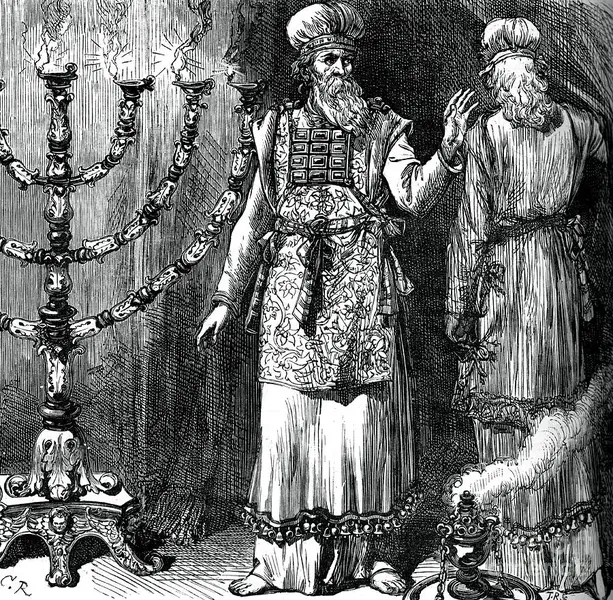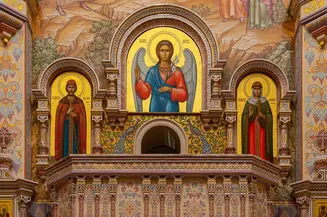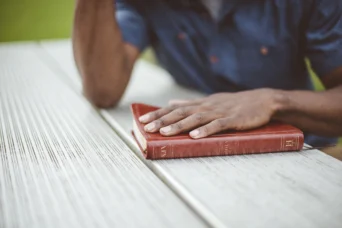How Did God Speak Through the Ephod?
September 2022
Reading through the Old Testament, we have stumbled across the word “ephod” a few times. Some people just skip it saying ‘oh, that must be something people of that time used, shouldn’t matter now.’ But it carried great weight in biblical times, and as a result, its spiritual meaning is still of importance to us in present times.
So what is an ephod? What was it used for, and why was it so important in the Old Testament?
What is the Ephod Meaning in the Bible?
In Scripture, there are two references to it.
One talks about an apron-like dress of a high priest in Israel. Describing it, Exodus 28:6 says it was made of “gold, of blue and purple and scarlet yarns, and of fine twined linen, skillfully worked.”
Exodus 28:12 also mentions onyx stones engraved with the names of the 12 tribes being set in the ephod over the shoulder straps.
In dressing the priest during those times, the ephod was the garment on which the Hoshen, or breastplate containing Urim and Thummim, rested. It was fastened at each shoulder piece and held together by a girdle around the waist like an apron.
Other references to it in Scripture talk about what is believed to be a portable idol. Judges 8:26-28 talks about Gideon making an ephod from 1,700 shekels of gold sourced from the gold earrings of the Ishmaelites, and putting it in his city where Israel came to worship it.
The man Micah in Judges 17:5 also made one for himself and set his son as priest to it. Another reference to it in such light is in Hosea 3:4,
” …without ephod or household idols“
Here it is used together with the word “teraphim“ which means ‘graven image’.
So we can deduce from these references that the ephod is also a word for some type of idol.
Ephod Picture

The Ephod, often described in biblical accounts, was an integral part of the High Priest’s vestments in ancient Israel. It was a richly decorated garment worn over the chest, intricately designed with fine materials and adorned with precious stones, representing the twelve tribes of Israel. These stones were not merely decorative but served as reminders of the people the High Priest represented before God.
In various biblical depictions, especially in the Book of Exodus, the ephod’s significance is highlighted, emphasizing its role in religious rituals and ceremonies. The visual representation or picture of the ephod provides a glimpse into the ancient religious practices and the deep symbolism embedded within the attire of the Israelite High Priest.
When Was The Ephod Worn In The Bible?
It was worn by the high priests of the Levitical priesthood alone during rites and any period they came before God’s presence.
God had instructed that they were not to wear ordinary clothing during their service, but that they were to put on “holy garments” made by those whom the Lord had “filled with the spirit of wisdom.” (Exodus 28:2–3)
Along with the breastplate and the Urim and Thummim, the ephod was also used as a means of divination.
Exodus 29:29 also records that the office of the high priest, along with the ephod and all the sacred garments were passed from Aaron to his son and then through the descendants of Levi. Later in the Bible, 1 Samuel 2:18 records that Samuel wore a linen ephod while serving before the Lord. King David also wore one in 1 Chronicle 15:27 as he and others carried the ark of the covenant into Jerusalem.
What Was The Purpose Of The Ephod?
Its primary purpose was to play a part, along with the breastplate containing the Urim and Thummim, in communication with God to know His will and seek His counsel.
David, after hearing that Saul was plotting against him, went to Abiathar the priest in 1 Samuel 23:9, and asked him to “bring the ephod”. Then he asked God for guidance, and He told him what to do.
Later in 1 Samuel 30:7, he repeated the same thing when he needed to inquire of God again.
The ephod stood as part of the only known way to access God in those times. The high priests never went into the Holy of Holies without it and other sacred garments. They would have been struck dead because they were too unclean. Even when Gideon and Micah set up the idols, in a way, it was their attempt at the same purpose; establishing a connection to the divine.
The ephod was also a symbol of the people and their sins. God told Moses the two engraved stones on the ephod were “memorial stones for the sons of Israel” and that “Aaron is to bear the names on his shoulders as a memorial before the Lord” (Exodus 28:12).
As a mediator between God and men, the priest bearing the ephod stood as a reminder that mankind could no longer come to God without someone in-between because of their sins and Adam’s fall from grace.
What Was the Spiritual Purpose of the Ephod in the Bible?
Here’s a brief explanation of how God communicated through the ephod:
- Urim and Thummim: Inside the breastplate of the ephod were two mysterious objects called the Urim and Thummim. The exact nature and appearance of these objects are not detailed in the Scriptures, but they served as divinatory tools. When questions were posed, the Urim and Thummim were consulted, and through them, God provided answers. How they indicated God’s answers is not explicitly mentioned, but some believe it could have been through a series of “yes” or “no” responses or through more complex revelations.
- Breastplate with Twelve Stones: The ephod’s breastplate held twelve precious stones, each representing one of the twelve tribes of Israel. This arrangement served as a constant reminder that the High Priest bore the responsibility of all the Israelites when standing before God. While the stones themselves were not tools of direct communication, they emphasized the connection between God, the priest, and the people.
- Prophetic Revelations: On some occasions, while wearing the ephod, prophets or priests might receive divine revelations. The ephod might serve as a focal point or facilitator for such communication.
It’s crucial to understand that while the ephod was an instrument through which God’s guidance could be sought, it wasn’t the only way God communicated with His people. Prophets, dreams, direct intervention, and other means were also used throughout the Bible.
The ephod, with its Urim and Thummim, was one of the more systematic and tangible methods employed, especially for decisions that affected the entire Israelite community.
Is Ephod Used In Christianity Today?
The Levitical Priesthood with the ephod suffered a huge loss because of Israel’s sin and idolatry. God departed from them and refused to speak anymore.
Hosea 3:4 puts it this way,
“For the children of Israel shall dwell many days without king or prince, without sacrifice or pillar, without ephod or household gods.”
This was Hosea prophesying that they would no longer have a means of communicating with God and for many years, God’s voice left Israel.
In His mercy, and in order to fulfill His redemption plan for mankind, He sent Jesus to the earth very many years later to die for the sins that kept man away from God. When Jesus died, the veil in the Holy of Holies was torn from top to bottom. This was symbolic of the fact that God would no longer hide, or wait for an ephod to speak to His people.
We were granted free access to come before His presence without fear of being struck dead because our sins were paid for. God Himself in the form of His Spirit left the temples and decided to dwell on the inside of us.
In Christianity today, we do not need an ephod or anything else to communicate with God. That’s because we already carry Him with us wherever we go. We can approach Him to seek His counsel whenever we want because He lives within us.
Final Thoughts
The physical ephod may have been lost in today’s Christianity, but its significance remains. This revelation should brew in us an appreciation for the freedom of communication we have with God because of Jesus’ death on the cross.
The magnitude of His sacrifice becomes clearer when we consider that without it, we would still have to run around seeking a biblical ephod before we could talk to God.
All the crying to God in the bathroom, prayer walks, talking to him while we work, and basically remaining in sync with him through our day would not be possible if not for Jesus. Like every good gift, the best way for us to cherish and appreciate this access is by using it well. Commit to talking to God every day and see how much transformation starts to happen with you.

In this article:




